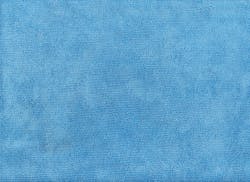Microbial efficacy of new and reprocessed microfiber in a clinical setting
Manual cleaning of environmental surfaces is a critical component of HAI risk reduction. A study published in the American Journal of Infection Control (AJIC), demonstrates that the microbial removal efficacy of the tested microfiber product is substantially equivalent at the beginning and end of its lifespan.
Microfiber has been shown to enhance microbial removal, but it is vital that it maintains sustained efficacy throughout its purported lifespan. This is especially important when supply chains are disrupted, as seen during the pandemic, and durable products must be relied upon to be effective after multiple reprocessings.
Existing literature on the sustained efficacy of reprocessed microfiber yields mixed results, but notably does not report laundry parameters consistent with Centers for Disease Control and Prevention recommendations.
Theories for the different outcomes range from the laundering process causing irreversible damage to the microfibers, thereby reducing efficacy, to it enhancing efficacy by rendering the fibers increasingly finer.
Diab-Elschahawi et al reported that, compared to cotton and sponge cloths, the decontamination efficacy of one microfiber product was reduced after 10 and 20 washings.
These cloths were washed at 90°C(194°F) for 5 minutes without bleach, dried in a dryer, with no specification of detergent additive or drying temperature. A 2021 critical review of reprocessed healthcare textiles studies posits that Diab-Elschahawi's conclusions warrant scrutiny given non-transparent statistical analyses.
The review further points to the study's findings that while new microfiber outperformed reprocessed for Staphylococcus aureus removal from ceramic tiles, the opposite was true for E.coli removal.
Smith et al evaluated nine different microfiber cloths washed one, 50, 75, 100, and 150 times with a microfiber-recommended detergent but without bleach, using a temperature of 71°C (160°F) for 3 minutes and air-dried.
They found that microbial removal efficacy improved after repeated washings (up to 150) compared to after a single washing.
Wiencek reported that ATP removal from floors was less effective with reprocessed vs. disposable microfiber mop pads, but did not quantify results or provide laundering parameters/number of laundering cycles.As only one microfiber product line was evaluated, results cannot necessarily be extrapolated to microfiber products from other manufacturers given product construct and design differences. Because the laundry process is most often implicated as the source of damage to microfiber, this study evaluated microfiber after 200 launderings only and not 200 launderings and ‘uses.’
In conclusion, this study found new and laundered microfiber cloths and mop pads achieve similar microbial removal efficacies in a clinical setting. This suggests that, when laundered according to CDC parameters, the microbial removal efficacy of the microfiber products tested is sustained throughout its claimed lifespan, a finding with important infection prevention and control implications. Future studies are needed to assess the sustained efficacy of other microfiber products.
